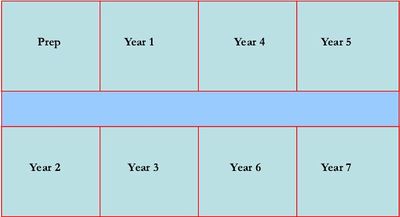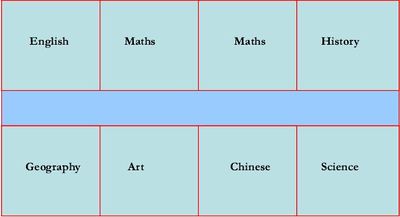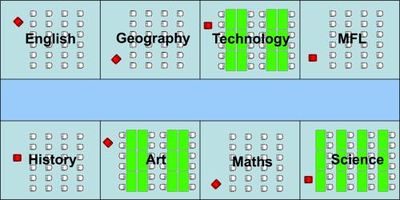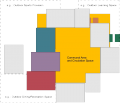Category:School Design
From DT Online
Design and Technology is about changing the made world and touches on all the skills needed to create new environments - including schools!
Look at your own school and imagine you were involved in its design - or perhaps you would like to think about how it could be improved? Look at schools built 50yrs ago . . . and 100yrs ago . . . what might they look like 50yrs from now?
The following guidance is intended only to provide some vocabulary and starting points and to take the opportunity to think about some basic principles.
- Some interesting web sites that show examples of school design (click on titles to view) :
- CABE - the government’s advisor on architecture,urban design and public space from 1999 to 2011.
- Fielding Nair International - educational facilities planning and architectural design and the developers of EFEI - an assessment tool that measures how well educational facilities are able to support best-practice.
- US School Design - a virtual gallery of American School & University magazine's Architectural Portfolio and Educational Interiors Showcase issues.
Its all in a name?
Think about what you should call each subject or group of subjects. What will you call the spaces in which each of these are taught? Does it matter?
- Consider for example 'Woodwork and Metalwork as opposed to Handicraft or Design and Technology; is Domestic Science the same as Home Economics, Cooking or Food Technology? It is clear that the name does imply some aspects of the subjects being taught.
- Is a Studio the same as a Workshop and what would you expect to see in a Factory Floor? Does Learning Space suggest something more flexible than Classroom?
- Which subjects would you expect to combine in a Design Faculty as opposed to a Technology Faculty? Is Zone a more useful term than Faculty?
‘Cells and Bells’
If learning spaces are all the same shape and size perhaps they constrain too much the variety of teaching styles that can make learning fun?
- Traditional primary school classroom block
The illustration shows a traditional primary school classroom block. Each classroom is the same size, same shape and are aligned along a corridor.
- do you know of any schools designed like this?
- what does it say about the basis on which classes are organised?
- could classes be organised differently - eg by ability reached, mixed ages or other ways?
- how easy would it be to combine classes for a topic, presentation or project?
- what does it say about the size of class in each year group?
- what does it say about the type of activities each year group do?
- do all activities require the same shape and size of space?
If the prompts above give you cause to question the effectiveness of this simple traditional arrangement, what would you do differently?
- Traditional secondary school teaching block
The illustration shows a traditional secondary school teaching block. Each classroom is the same size, same shape and are aligned along a corridor.
- do you know of any schools designed like this?
- what does it say about the basis on which subject groups are organised?
- how easy would it be to combine subject groups for a topic, presentation or project?
- what does it say about the group size for different subjects?
- what does it say about the type of activities each subject involves?
- do all activities require the same shape and size of space?
If the prompts above give you cause to question the effectiveness of this simple traditional arrangement, what would you do differently?
- Influence of spaces on teaching styles
The illustration shows a traditional classroom block. Each same size classroom is furnished with 24 pupil desks and chairs plus one teacher chair.
- does this limit the ways in which a teacher can interact with a class?
- is the number of ways the class can be set out restricted?
- are all subjects taught the same way?
- do all subjects need the same space?
- how easy would it be to organise group work for example?
- what would happen if more than one teacher was needed?
- how easy is it for teachers or pupils to move about?
If the prompts above give you cause to question the effectiveness of this simple traditional arrangement, what would you do differently?
Pages in category "School Design"
The following 6 pages are in this category, out of 6 total.
Media in category "School Design"
The following 8 files are in this category, out of 8 total.
- AreaDataSheetExtract2.jpg 500 × 334; 104 KB
- CampusPlan3.png 1,075 × 687; 67 KB
- DTplan2.png 1,253 × 820; 583 KB
- HellerupCirculationSpace.jpg 523 × 351; 189 KB
- ScienceGarden.jpg 386 × 281; 96 KB
- SquarePlan3.png 715 × 614; 52 KB
- StreetPlan3.png 1,190 × 475; 57 KB
- ZonePlan2.png 1,192 × 690; 322 KB









